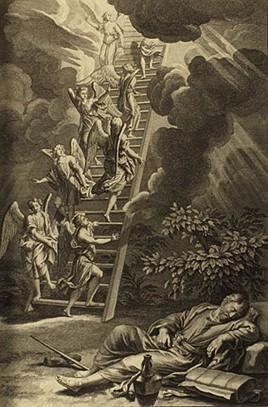Stairway to Heaven
“The truth is what ennobles” – Søren Kierkegaard, Danish philosopher

Many story techniques may be used by a coach to create a safe space, assist a client to raise their awareness, obtain learning and insight, identify values and dynamics, consider alternative paths and their consequences, come to a resolution, embark on a change journey, receive comfort and affirmation.
They include deep listening, journaling, time-lining, reframing, archetypal descriptions, metaphor-elicitation, dreamwork and active-imagination exercises, developing the elusive attribute of presence.
In this article I introduce the use of image as a tool to stimulate the image-ination (A different reality).
The image may be a drawing done by a client to describe a situation, feelings, dilemma, fear. Or a photograph that prompts memories. Or a painting or illustration introduced by the coach to begin an exploration around a topic that has emerged. Sometimes the image is held in the mind, triggered by a visual story.
Imagination
Jan Taal from Amsterdam is a Clinical Psychologist, trained in Psychosynthesis (the intersection of spirituality and psychology). He has a love for the use of allegory as a natural means of healing, that brings inner freedom and upliftment. He founded the School for Imagery in the 1970s.
I recall sitting with Jan several years ago in a café in Kloof Nek Road , Cape Town (one of South Africa’s oldest roads). In his quiet, gentle, unassuming way Jan provided new, exciting insights into the therapeutic qualities and imagination-provoking possibilities of images.
Since meeting with Jan, I have come to appreciate why imagination is such a core function of the psyche.
Powers of imagination when contemplating the always unknown future may invoke anxiety and distress. And looking into the past may yield guilt, regret, resentment. These “new brain/ mind troubles”, are eloquently described and explained by British psychologist Paul Gilbert. (Gilbert, P. 2013)
On the other hand, as cultural historian Richard Tarnas points out, our relatively new human capacity to imagine is a wonderful and dynamic mental force that allows us to see hidden truth in myths and archetypal meaning, and make conscious our place in the universe, indeed – broaden our concept of reality. (Tarnas, R. 1991)
Consider letting go of a habit or addiction, desire, recurring thought, a past hurt and unforgiveness. Or worrying about an uncertain, threatening future and the rich conversation that may result from that.
A man was running for his life to escape a hungry tiger.
He came to the edge of a cliff, stepped over and held onto a vine. The tiger couldn’t reach him, but there was no way up again.
Looking down he saw another tiger at the bottom waiting for him to let go and fall.
A rat appeared and began gnawing at the vine.
The man noticed a strawberry growing on the face of the cliff.
He held the vine with one hand and with the other grabbed the strawberry and ate it.
How sweet it tasted!
The tiger on top of the cliff represents our past, and the tiger waiting below the future.
Images
Thomas Moore says: “Images flow through the mind without limit … like ants, which invisibly sustain the life that is almost always unconscious of their presence …The images that form the raw material of our imagination are the most precious substance we have because from them we develop an attitude toward events and eventually a way of life”. (Moore, T. 2000)
Images can enlighten, heal, liberate, introduce possibilities, add a higher element to our lives.
Gali Salpeter, a Norway-based expressive arts therapist, designs metaphorical, projective cards for therapeutic purposes. I have used her image cards for many years. Gali says that “A successful therapeutic process offers more than a helping hand; it gives a sensitive ear, a comforting voice, an observing eye, an accepting heart and a guiding mind. Therapists provide the setting, the stage where they would listen to their clients telling their narratives. During the sessions therapists hold, contain, edit, feel, think with, intervene, zoom in and rise above the narratives, searching for old and new voices, underlining words, asking ‘what if’ or ‘how come’ and often merely accompanying the storyteller quietly. It is within the therapeutic setting that new stories are born”. (Salpeter, G. 2010)
When clients plumb their depths, reach a state that pioneering psychologist William James called “torn-to-pieces-hood”, we may need something more: a counselling or coaching lever that allows those clients to enter a different type of engagement. “In the case of illness and crisis, imagery and artistic expression can help enhance one’s quality of life, strengthen a sense of meaning, improve interpersonal communication and reduce feelings of anxiety, fatigue, stress, pain and depression”. (Lombard, C.A. 2020)
As examples here are two of the many images that I have found to be valuable.
The fog

A painting by Angelo Desantis, called Fog, city, boat and bird has evoked reflections from clients on the analogy of the stormy seas that the boat is returning from, on the warm and sunny day that awaits once the fog has lifted, on the joy and freedom of the bird – no matter what may transpire. Some liken the coming and going of adversity and troubles to a poem by Carl Sandberg, called The Fog:
The fog comes
on little cat feet.
It sits looking
over harbor and city
on silent haunches
and then moves on.
Often, clients respond to this painting by reflecting on loneliness and uncertainty. How they were surprised by an unexpected creeping in and taking over: of a loss, death, a set-back in a relationship. Nothing they foresaw nor were able to control. And this is a reminder of the coach’s own fallibility and susceptibility to the unknown too: “Un-knowing or not-knowing is a central phenomenon in experiential therapies. The Un-Known as an existential given. Un-knowing does not only help us to attune to our clients, there is also the fact that we simply don’t know”. (Vanhooren, S. 2016)
One aspect of spiritual maturity is the capacity to practice the unknown – with mindfulness, curiosity, contemplative wisdom, and humour.
Jacob’s Ladder

Angels are a reality for the major religions … Zohar, Kabbala, Islam, Christianity, Hasidic, Hinduism, Buddhism … Many of the deities in the Tibetan world have almost the same characteristics as certain archangels in the Western world. (Cooper, D. 2006)
The Talmud teaches that everyone has their own guardian angel. Psalm 91:11 refers to “…….angels to protect you, to watch over you in everything you do”, and a core Jewish meditation is to invoke the presence of archangels Gabriel, Michael, Uriel, Raphael and the Shekhina presence to guard, protect, provide strength, justice, insight, lovingkindness. When the Dalai Lama met Rabbi Zalman Schachter-Shalomi, as described in ‘The Jew in the Lotus’, the Buddhist leader was enthralled by the Jewish perspective on angels. (Kamenetz, R. 1995)
I love the image/ metaphor of the ladder seen by Jacob in his dream – connecting heaven and earth – with angels continually going up and down the ladder.
“And he dreamed, and behold a ladder set up on the earth, and the top of it reached to heaven: and behold the angels of God ascending and descending on it“. (Genesis 28:12)
When appropriate, this image may be welcomed by a client. A bridge provided by ‘God’ to provide access, connection, comfort and love. Clients have reported: ‘The painting shows that this situation of mine in not unique but has been happening for centuries as the material and spirit/ energy worlds interact’, ‘I no longer feel that I am alone’, ‘Angels come in many different forms on the figurative stairway between earth and heaven: a stranger, the joy and love of a pet’, ‘I can be an angel to others who need help’.
Imagination is a therapeutic resource
Two men share a hospital ward.
Paul is bedridden, dying.
Ghulam is near the window. Every day he stands up, looks out, and relates to Paul what the world outside is like. He describes beautiful park gardens, birds, a bubbling brook. A mother comforting her child. People holding hands as they walk.
Unexpectedly, Ghulam dies. But his healing word-pictures have resulted in Paul’s recovery.
Paul asks if he may move to the window bed.
When he looks out of the window he looks directly at a blank, brick wall across the narrow road.
“What if you slept
And what if
In your sleep
You dreamed
And what if
In your dream
You went to heaven
And there plucked a strange and beautiful flower
And what if
When you awoke
You had that flower in your hand
Ah, what then?” (Samuel Taylor Coleridge)
Illustration Source:
Desantis, Angelo (Berkeley, US) (2009) Fog, city, boat and bird Creative Commons Attribution 2.0 Generic license.
Grogan, Tony Two men in a hospital ward
Hoet, Gerard Jacob’s Ladder Illustration from the 1728 Figures de la Bible. Published by P. de Hondt in The Hague; image courtesy Bizzell Bible Collection, University of Oklahoma Libraries
Bibliography
- Cooper, Rabbi David A. (2006) Invoking Angels Sounds True, Inc. Boulder, Colorado 2006
- Fynn (1974) Mister God This Is Anna Fountain/Collins
- Gilbert, Paul (2013) The Compassionate Mind Constable, London
- Kamenetz, Rodger (1995) The Jew in the Lotus: A Poet’s Rediscovery of Jewish Identity in Buddhist India Harper Collins
- Lombard, Catherine Ann (2020) The Art of Healing Therapy Today
- file:///C:/Users/cents/Desktop/SteveQuestions/STORY/Imagery-Toolbox.-The-Art-of-Healing.-Therapy-Today-June-2020.pdf
- Moore, Thomas (2000) Original Self Perennial (Harper Collins) NY.
- Salpeter, Gali (2011) The River Guidebook http://www.storyandtherapy.com
- Tarnas, Richard (1991) Passion of the Western Mind Pimlico
- Vanhooren, Siebrecht (2016) The Un-Known and practicing un-knowing edX Course: Existential Well-being Counseling: A Person-centered Experiential Approach. Meaning and Spirituality Module (October 2016 to June 2017)
- Williams, Graham (2020) Putting Things Right Storytelling in Business Blog (http://storytellinginbusiness.blogspot.com/2020/08/putting-things-right.html)

Graham Williams
About the Author
Graham Williams is an executive coach and management consultant who lives in Cape Town, South Africa. He has worked in over 40 countries in a variety of sectors, authored 9 business books and is a Management Contributor for 12Manage, the world’s #1 management network.
Graham uses narrative, anecdote, metaphor, archetypes, poetry, imagery and conversations in his work. He is passionate about facilitating healing and wholeness in organisations and their members. And is often asked to conduct workshops for coaches on competency development and application areas suitable for the effective use of story, and the powerful possibilities inherent in story.
In this six-part series Graham shares his insights into a number of the key skills required by modern-day coaches.
He may be contacted at [email protected]
Want to read more articles like this? Check out our Author Speaks page, here you will find more such content.





